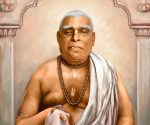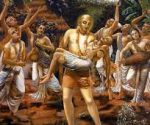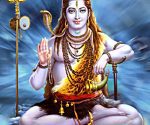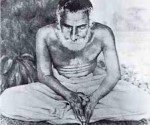Who Is Lord Narashimhadeva
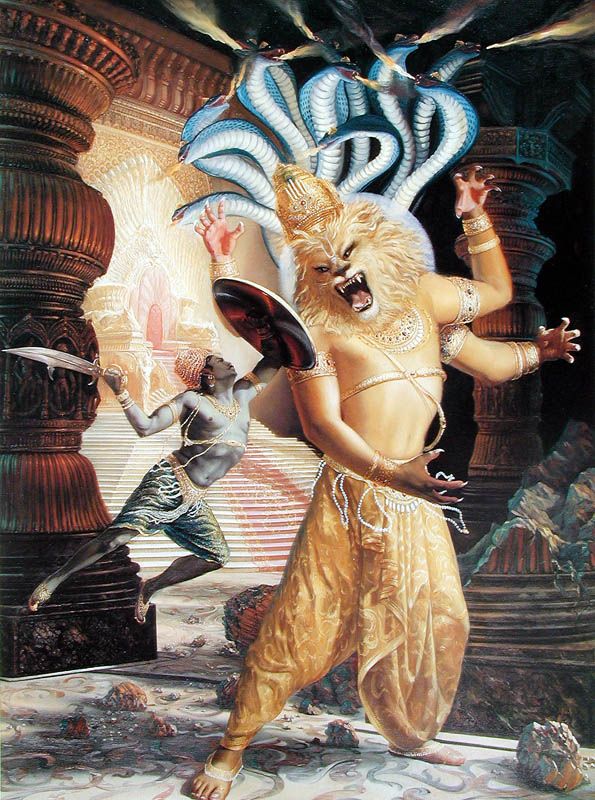 Srimad Bhaktivedanta Narayana Gosvami Maharaja
Srimad Bhaktivedanta Narayana Gosvami Maharaja
Appearance Day Lecture on May 14, 2003, in Badger, California.
Today is the auspicious appearance day of Lord Nrsimhadeva. Who is Nrsimhadeva? He is Krsna Himself – “Kesava dhrta narahari rupa.” Krsna Kesava – He is the same Kesava (a name of Krsna meaning that He has fine hair), but not directly. He is none other than Cakra. Krsna’s cakra (wheel-shaped weapon) becomes Nrsimhadeva. When there is a temple installation of Cakra, the prayers are offered to Nrsimhadeva.
Lord Nrsimhadeva’s main mercy is to protect the devotees. The Cakra who saved Ambarisa Maharaja was Nrsimhadeva himself, and the Cakra who killed Sisupala was also Nrsimhadeva; there is no difference between the two. All the paraphernalia (weapons) in the hands of Krsna manifest as His Visnu incarnations; and it can also be said that His incarnations are manifestations of Baladeva prabhu.
If you have any difficulties or problems given by demons or others, and you call Nrsimhadeva, He will come and save you. Vaisnavas therefore have a special consideration regarding Nrsimhadeva. We do not worship many other incarnations, like Vamanadeva or Kurmadeva, or Kalki, but we do worship Nrsimhadeva.
Since there will be no cooking in the morning or midday today, I would like all the sannyasis and prominent speakers, one by one, to read continuously from the Srimad-Bhagavatam Seventh Canto (*See Endnote 1), and to also explain the verses – up to Prahlada Maharaja refusing to accept a material boon from Lord Nrsimhadeva. The readings should include the way in which Prahlada taught all the demon boys and made them maha-bhagavatas. In other words, it should include the chapter in which the verse beginning “guru susrusaya” is included. I would like that all of you attend and hear these readings.
There is no need of taking prasadam before dusk, the time of Nrsimhadeva’s appearance. Only children and those who are old and sick, or those whose doctors have advised not to fast – they may take something for their maintenance. If Nrsimhadeva sees that you are all fasting and taking so much trouble, He will be pleased. Otherwise, if you joke and make merry, He will neglect you. It is for Nrsimhadeva that you are accepting this austerity, for all of you to attract his mercy.
Today we do this austerity, as we do on Ekadasi, Caitanya Mahaprabhu’s appearance day (Gaura Purnima), Rama-navami (the appearance day of Sri Ramacandra), and other holy appearance days like Janmastami and Radhastami. These austerities are not like those performed by the yogis; these are performed to attract Krsna’s mercy, so try to follow.
I now want to begin our glorification of Lord Nrsimhadeva.
Yudhisthira Maharaja once performed a Rajasuya sacrifice. *[See endnote 2] He sent his army, under the guidance of Bhima and Arjuna, to conquer the entire world; but He did not want to kill anyone. He told his leaders that if the kings and princes of the other lands surrender without fighting, they should simply take a tax from them, and those kings and princes who wanted to fight could fight. Bhima and Arjuna traveled everywhere and took taxes from all the kings, and when they returned, a very high class of fire sacrifice was performed.
The question arose at the sacrifice as to who would be worshiped first so that the festival would be successful. Sahadeva proposed, “Krsna should be worshiped first, because He is the Lord of Lords, the Supreme Lord, and He is here.”
Bhisma-pitamaha and others supported this proposal, but Sisupala became very angry. At that time Sisupala was the leader of Duryodhana and all the other demons. He was envious of Krsna and wanted to kill Him. He knew about the foretelling at his birth that Krsna would kill him, so he thought that he should kill Krsna first and be saved. He had previously wanted to marry Rukmini, but clever Krsna had kidnapped her in front of him and all the other princes and kings, defeated them all, and then married her.
Krsna is satisfied and complete (purna). He needs nothing in this world and He has nothing to take from anyone. Still, for the enactment of His transcendental pastimes He kidnapped Rukmini and married her, and Sisupala and the others could simply wring their hands. When Krsna was leaving their midst with Rukmini, the other princes and kings had exclaimed, “Alas, this bogus black person, in front of generals like Jarasandha and others, has kidnapped her – and they could not stop Him. He defeated them all and took her away!” Thus, Sisupala wanted to take revenge.
Now, at the Rajasuya sacrifice. he looked at Krsna and began to criticize him and call Him ill names. He challenged, “Who is this person?!” Krsna actually has no father or mother, but Sisupala accused Him that, “This person has two fathers, and no-one knows who His real father is. He has no varna (caste) and no one knows where He is from. He is not only a thief, but a lusty person – very lusty. When He sees any lady He becomes attracted; and somehow, by trick, He brings those ladies to Him. Moreover, He is not satisfied with only one lady; He must have thousands and millions of ladies. Not only this, He once climbed on a tree with the garments of the gopis who were taking bath naked, and He told them that they should come before Him one by one to get their clothes. What is this silly thing?! You have no intelligence; you are so mad that you have selected Him to worship first. As long as I am here, I will not allow this!”
Hearing this, Duryodhana and other demons clapped.
Sisupala considered that as long as he was present, he would not let anyone perform their first worship to Krsna. He said that he would fight for this not to happen, and he thus managed to utter his one hundredth offense.
When Sisupala’s mother had given birth to him, he had four arms. At that time an aerial voice announced that the person who Sisupala would see and two of his arms would disappear, that person would later kill him. All the relatives had come to see this beautiful and strong four-handed child. Out of social custom, Krsna took many ornaments for that boy, and being a representative of His father He came to see His cousin-brother. When He came near Sisupala He wanted to take him in His arms, but Sisupala’s two arms at once disappeared. His mother began to weep loudly and said, “Krsna, You are my nephew, so I want to request a boon from You. It has been foretold by an aerial voice that whoever my son sees, thus making his two arms disappear, would later kill him. I pray for You not to kill him – even if he offends You.” Krsna replied, “Oh yes, I am giving you this boon. I will kill him only when he abuses Me more than 100 times – otherwise I will not.” His mother was very happy and said, “He will never do this. I will train him and teach him good behavior.”
When Sisupala became older, he learned of this fact. He therefore became angry and continuously abused Krsna. Now, when he had abused Him more than 100 times, Krsna took His Cakra. The Cakra wanted to go very fast – not slowly, as it had moved when it had chased Durvasa. It had been only following behind Durvasa and not killing him. For Sisupala, on the other hand, it sliced off his head at once. A very effulgent light immediately came from Sisupala’s body. That light went into the sky and then entered the body of Krsna.
Yudhisthira Maharaja wondered why rsis, yogis and maharsis, after thousands of births of chanting mantras like “so ‘ham, so ‘ham” still could not attain the destination of sayujya-mukti (impersonal liberation). How wonderful it was, then, that this light entered the lotus feet of Krsna. But where did it go?
Narayana was present within Krsna’s body, because all the incarnations are always in Krsna, the Supreme Lord. Sisupala thus returned to Narayana in Vaikuntha and became His doorkeeper Jaya, but this was not seen externally. The entire world is in the stomach of Krsna. Narayana and other incarnations can also easily fit there, but still His stomach can be empty and He can feel hungry.
Yudhisthira Maharaja was not an ordinary person. Bhima was very strong and powerful, and Arjuna was also. However, when we consider who was stronger –Yudhisthira, Bhima or Arjuna – we find that where Arjuna and Bhima were not successful, Yudhisthira Maharaja was successful by his mere glance. Bhima was once wrapped up by the body of a snake, and that snake would not release him. Yudhisthira then came, simply glanced at that serpent, and it left at once. So do not think that Bhima and Arjuna are more powerful than Yudhisthira. Arjuna’s bhakti is superior to the others’, but dharma was especially present in Yudhisthira Maharaja. That is why he was called Dharmaraja, and that is why he was so powerful.
When Yudhisthira Maharaja saw Sisupala’s soul enter Krsna’s body, he began to think, “How wonderful! Even a yogi, rsi or muni does not receive this kind of mercy from Krsna.” He then asked Narada Rsi, “You know everything and you can remove all my doubts. So please explain this: Krsna has no fear of anyone and He does not want anything from anyone. He is purnatama (complete), atmarama (always happy internally) and aptakama (satisfied and equal to all). So why does He take the side of devotees and demigods? And why does He defeat or kill demons? I want to know why.”
Narada replied that the cause of all this is kala (Time) – the results of past activities. Sometimes, like during Satya-yuga, (the Age of goodness), the demigods and others like them become prominent. In Kali Yuga, on the other hand, the demons are more powerful. It seems that Krsna helps certain personalities, but actually the events of this world are controlled by Time. Krsna is equal to all, and everything here is thus due to kala.
You should not be angry or criticize anyone. If you are in distress or disturbed by many problems, it is due to you, yourself:
tat te ‘nukampam su-samiksamano
bhunjana evatma-krtam vipakam
hrd-vag-vapurbhir vidadhan namas te
jiveta yo mukti-pade sa daya-bhak
[“My dear Lord, one who earnestly waits for You to bestow Your causeless mercy upon him, all the while patiently suffering the reactions of his past misdeeds and offering You respectful obeisances with his heart, words and body, is surely eligible for liberation, for it has become his rightful claim.” (Srimad-Bhagavatam 10.14.8)]
Eva atma krtam. What one has done in the past is now coming back to him. If one is a pure bhakta and the results of all his past activities are finished, why would problems come to him? His so-called problems are due to the mercy of Krsna. Problems are not coming; Krsna is sending them. The Pandavas were praying for great calamity so that Krsna would be with them. Krsna gave them great distress – as he gave to Draupadi when Dusasana tried to remove her clothes – and He did the same to Prahlada Maharaja.
He gave Prahlada so many troubles. Why? He considered, “The entire world should know that My devotees are exalted; they do not care about saving themselves, so I must save them.” You can know all these truths by reading Srimad-Bhagavatam.
You should read Srimad-Bhagavatam Seventh Canto until 6:00 p.m., at which time I will return, and then we will perform abhiseka (the bathing ceremony) of Nrsimhadeva. Some flowers should also be here for offering.
We will observe today as we do Ekadasi, and we can break our fast after Nrsimhadeva’s birth (dusk). If anyone wants to break his fasting before that time, he may take only fruits and vegetables. If anyone wants to fast until tomorrow morning, he can do so very easily. Then, tomorrow we will worship Nrsimhadeva, and after that we will take prasada. Now, bring Seventh Canto and begin.
Gaura Premanande.
[*Endnote 1 (from Srimad-Bhagavatam 7.8 Summary by Srila Bhaktivedanta Swami Prabhupada):
Hiranyakasipu was ready to kill his own son Prahlada Maharaja [for preaching Krsna consciousness], but the Supreme Personality of Godhead appeared in front of the demon as Sri Nrkesari, half lion and half man, and killed him.
Following the instructions of Prahlada Maharaja, all the sons of the demons became attached to Lord Visnu, the Supreme Personality of Godhead. When this attachment became pronounced, their teachers, Sanda and Amarka, were very much afraid that the boys would become more and more devoted to the Lord. In a helpless condition, they approached Hiranyakasipu and described in detail the effect of Prahlada’s preaching. After hearing of this, Hiranyakasipu decided to kill his son Prahlada. Hiranyakasipu was so angry that Prahlada Maharaja fell down at his feet and said many things just to pacify him, but he was unsuccessful in satisfying his demoniac father. Hiranyakasipu, as a typical demon, began to advertise himself as being greater than the Supreme Personality of Godhead, but Prahlada Maharaja challenged him, saying that Hiranyakasipu was not God, and began to glorify the Supreme Personality of Godhead, declaring that the Lord is all-pervading, that everything is under Him, and that no one is equal to or greater than Him.
Thus he requested his father to be submissive to the omnipotent Supreme Lord.
The more Prahlada Maharaja glorified the Supreme Personality of Godhead, the more angry and agitated the demon became. Hiranyakasipu asked his Vaisnava son whether his God existed within the columns of the palace, and Prahlada Maharaja immediately accepted that since the Lord is present everywhere, He was also present within the columns.
When Hiranyakasipu heard this philosophy from his young son, he derided the boy’s statement as just the talk of a child and forcefully struck the pillar with his fist.
As soon as Hiranyakasipu struck the column, there issued forth a tumultuous sound. At first Hiranyakasipu, the King of the demons, could not see anything but the pillar, but to substantiate Prahlada’s statements, the Lord came out of the pillar in His wonderful incarnation as Narasimha, half lion and half man. Hiranyakasipu could immediately understand that the extraordinarily wonderful form of the Lord was surely meant for his death, and thus he prepared to fight with the form of half lion and half man. The Lord performed His pastimes by fighting with the demon for some time, and in the evening, on the border between day and night, the Lord captured the demon, threw him on His lap, and killed him by piercing his abdomen with His nails. The Lord not only killed Hiranyakasipu, the King of the demons, but also killed many of his followers. When there was no one else to fight, the Lord, roaring with anger, sat down on Hiranyakasipu’s throne.
The entire universe was thus relieved of the rule of Hiranyakasipu, and everyone was jubilant in transcendental bliss. Then all the demigods, headed by Lord Brahma, approached the Lord. These included the great saintly persons, the Pitas, the Siddhas, the Vidyadharas, the Nagas, the Manus, the prajapatis, the Gandharvas, the Caranas, the Yaksas, the Kimpurusas, the Vaitalikas, the Kinnaras and also many other varieties of beings in human form. All of them stood not far from the Supreme Personality of Godhead and began offering their prayers unto the Lord, whose spiritual effulgence was brilliant as He sat on the throne.
Endnote 2 – “After gaining victory in the Battle of Kuruksetra, Maharaja Yudhisthira, the Emperor of the world, performed the Rajasuya sacrificial ceremony. The emperor in those days, upon his ascendance to the throne, would send a challenge horse all over the world to declare his supremacy, and any ruling prince or king was at liberty to accept the challenge and express his tacit willingness either to obey or to disobey the supremacy of the particular emperor. One who accepted the challenge had to fight with the emperor and establish his own supremacy by victory. The defeated challenger would have to sacrifice his life, making a place for another king or ruler. So Maharaja Yudhisthira also dispatched such challenging horses all over the world, and every ruling prince and king all over the world accepted Maharaja Yudhisthira’s leadership as the Emperor of the world.”




